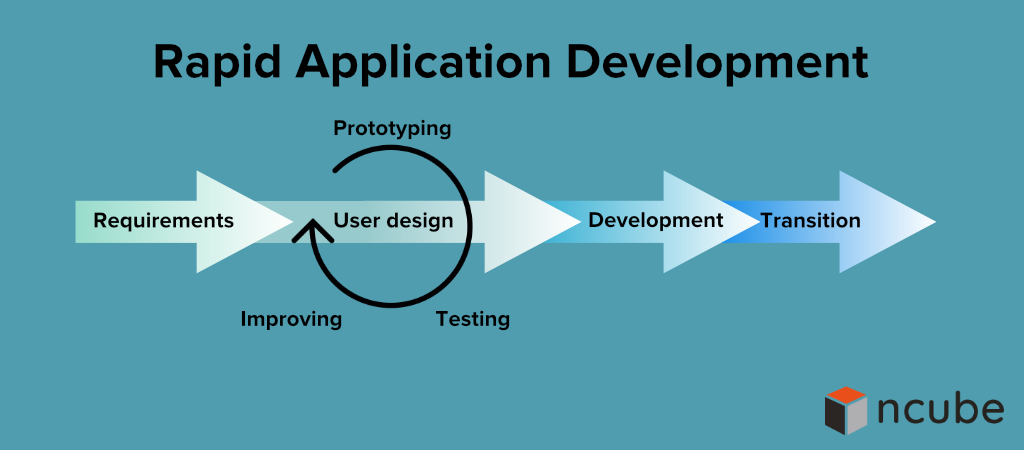
What is Rapid Application Development?

Unlike building a house, software development can be flexible. Nothing is set in stone here: you can alter the design on-the-fly, add features, or even restart and take a new direction without affecting the end product.
Such an approach requires a framework for teams to be efficient and adapt to changes quickly. In this article, we will take a look at Rapid Application Development, a software development framework that allows teams to build prototypes at record speed.
What is Rapid Application Development?
In essence, Rapid Application Development (RAD) is a model within agile software development with rapid prototyping at the forefront. With RAD, developers can use the insights gained during the development process and update software without needing to start the development process again each time.
The RAD model is a good alternative to the Waterfall model, which is more stringent and focused on the upfront planning of an entire system. It’s actually after the stage of testing that you will learn whether or not your product fits the ever-changing needs of the market.
The concept of fast development was coined by James Martin in 1991. RAD has long since become one of the most popular software development methods.
Pros and Cons of Rapid Application Development
Despite its usefulness, RAD is not a one-size-fits-all recipe. RAD approach is a good way to develop software quickly and you have a small team. Here are a few advantages and disadvantages of Rapid Application Development.
RAD advantages:
- Development time is significantly reduced
- Developers can make adjustments quickly
- Quick iterations
- User-centered approach and higher customer satisfaction
- Early integrations
- Prioritizes urgent features
- Increased productivity
RAD disadvantages:
- Applicable for small teams
- Needs close-knit collaboration
- Only skilled developers
- Dependent on user involvement
- High management effort
How does Rapid Application Development work?
Getting started with rapid application development involves four basic steps.
- Requirements
- User design
- Development
- Changeover

Requirements phase
In the first phase, designers, developers, and users agree on the scope, business needs, constraints, and requirements of the project. In the RAD model, the requirements are less stringent and detailed than in Waterfall. It’s enough to collectively agree on the broad scope of the project to move on to prototyping.
User design
Developers roll up their sleeves to build design through a series of iterations. This phase entails a joint effort of developers and users who will continually test the product to make sure it matches the expectations. Developers, in turn, will address this feedback to improve the product until it meets the needs of the users.
Development
Most works are done in the user design stage, including coding and testing. In the construction phase, developers work to deliver a working product. Given that users proactively shared their feedback in the previous phase, developing the final version takes less time than in Waterfall. During this phase, as in the previous one, feedback from clients is also welcome.
Transition
The final phase gives the development team time to move components into a live production environment where all the necessary comprehensive testing or user training takes place.
Now that we have looked at the four phases of Rapid Application Development, let’s explore if this model is a good fit for your project.
Rapid Application Development vs other software development models
Comparing RAD to other models, it becomes clear that it varies considerably. Rather than focusing on bringing a working product to the market, RAD is about building for a market fit. Also, within this model, prototypes are created and shown to users at record speed.
Another peculiarity is the constant user feedback, something that is hard to achieve with other models. In fact, in most models, user feedback takes the backseat until the product is finalized. Conversely, the RAD model encourages and prioritizes customer feedback. Developers and users work side by side, voicing opinions and reporting issues throughout development and prototyping stages.
Read Also: Software Development Life Cycle Guide
When does it make sense to opt for RAD?
The RAD model is a good way to improve collaboration between users, customers, and developers at all stages of the development process. Involving users is particularly useful in scenarios where user requirements are uncertain. Bringing users and developers together bridges communication gaps and provides ample opportunities to get the best out of customer involvement.
On the development front, the RAD-driven development process includes rapid prototyping with computer-aided software engineering tools that allow developers to reuse previously generated code, saving time required for manual coding.
Can your project be divided into loosely coupled modules?
If so, several teams can work concurrently, each assembling a prototype for one module. At the end of the iteration, the modules are combined into a single working application.
Does your project have well-defined requirements?
The RAD model suits projects in which users’ expectations are unclear from the start. Since the product is created in small iterations, during which the specifications and requirements are constantly altered, the customer will eventually end up with a product that meets his expectations in the best way.
Do you have a close-knit team of skilled professionals?
The goal of RAD is to quickly create a high-quality product. This is the task for the masters of the craft.
Are users ready to actively participate in the project?
User feedback is critical throughout an entire project. RAD suggests that there will be lots of discussions about functionality, testing the prototypes, updates, and ongoing feedback. If the user does not have enough motivation for this, trying standard models will make more sense.
Are you developing on a tight schedule?
RAD is the best choice for delivering a working product fast. Being haphazard by nature, this model eliminates the time-consuming stages of planning and design and lets you deliver exactly what your user wants.
Finally, do you have the budget?
Rapid app development can be expensive because you need to engage the best specialists in the market. The bright side is, you can hire high-skilled professionals outside your region, which is less expensive.
Our team at NCube can help you set up a development team that will utilize the RAD methodology (or any other methodology of your choice) to develop software under your leadership. Let us know about your project in the contact form and we will help you choose the best strategy.
Recommended articles


